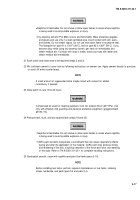TM-9-2350-311-34-1 - Page 96 of 352
WARNING
TM 9-2350-311-34-1
5-2 FUEL TANKS — CONTINUED
b. Repair
●
●
●
●
●
Do not smoke or use open flames when removing tanks. Wear respirator and
rubberized protective clothing when working on fiberglass. Fiberglass inhalation
can cause severe respiratory problems. Fiberglass particles embedded in skin will
cause irritation and possible infection.
Immediately after working with fiberglass and resin, thoroughly wash any exposed
skin surfaces. If fiber particles are imbedded in skin, do not scrub. Rinse area in
warm, soapy water and seek medical assistance.
NOTE
Upper and lower fuel tanks are repaired using same procedures.
Applying fiberglass and epoxy repair materials in cold shop retards curing.
Steps 1 thru 20 apply to tanks with repair holes larger than 1 in. (2.54 cm). Steps
21 thru 27 apply to tanks with cracks or punctures smaller than 1 in. (25.4 mm).
1 For holes larger than 1 in. (2.54 cm) across at any point, cut away damaged area. Make a smooth-edged
circular opening. Sharp angular cuts make repair more difficult.
2 Scarf crater with at least 1.5 in. (3.81 cm) sloping sides, down to opening.
Dry-cleaning solvent (P-D-880) is toxic and flammable. Wear protective goggles and
gloves and use only in a well-ventilated area. Avoid contact with skin, eyes, and
clothes. Do not breath vapors. Do not use near open flame or excessive heat. The
flashpoint for type #1 is 100°F (38°C), and for type #2 is 138°F (59°C). If you become
dizzy while using dry-cleaning solvent, get fresh air immediately and obtain medical
aid. If contact with eyes is made, wash your eyes with water and obtain medical aid
immediately.
3 Remove dust and clean repair area with dry-cleaning solvent.
NOTE
Presence of oil in repair area will result in poor adhesion.
4 Use 0.125 in. (3.2 mm) application of regenerated silica compacted under warm pad to withdraw oil for
improved adhesion.
5 Measure repair area and estimate material requirement.
5-14
Back to Top




















